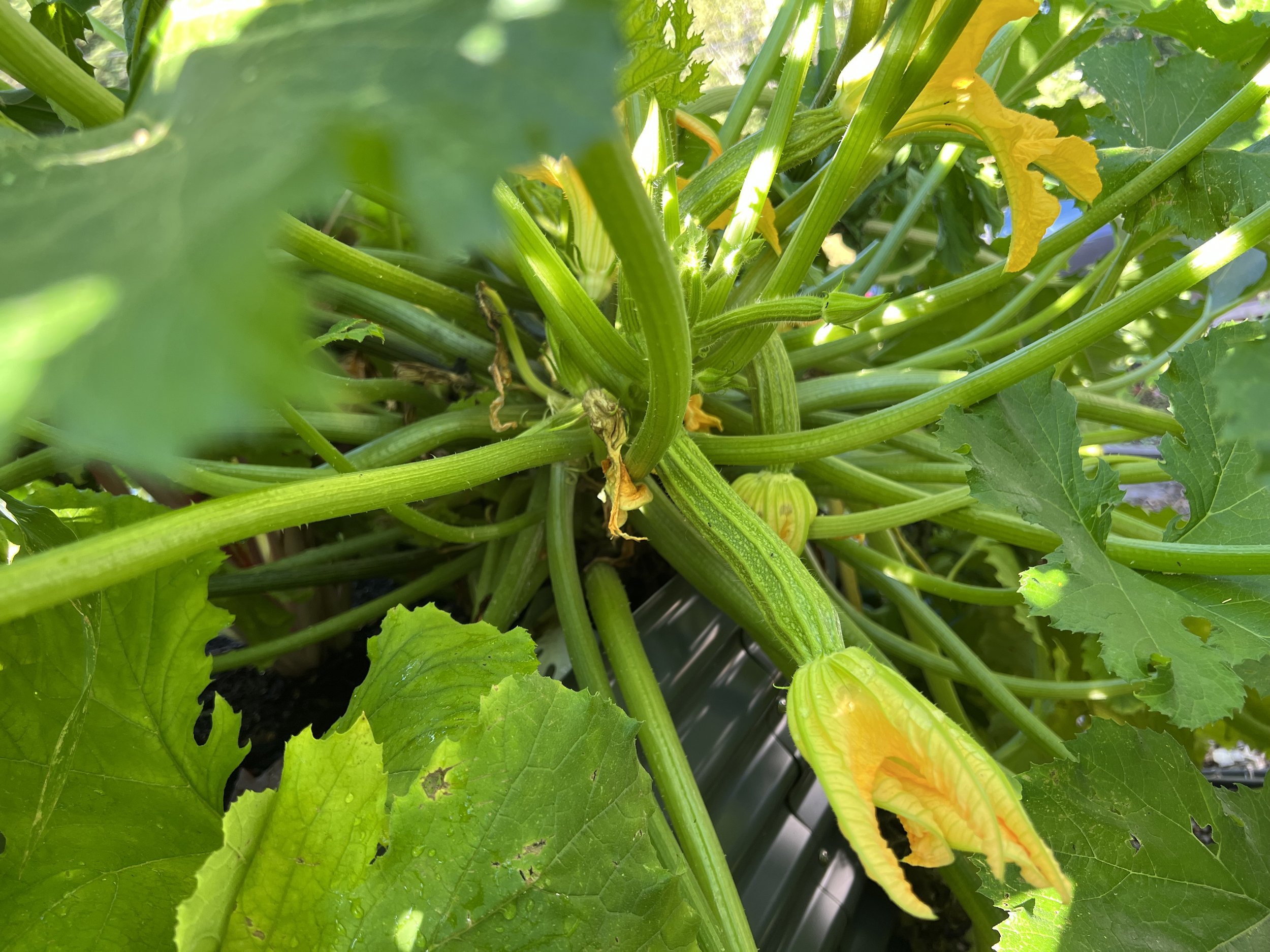Growing summer squash
Space individual plants 3 feet apart.
Before planting, add some general purpose fertilizer and compost to the soil.
Keep the soil evenly moist.
It can be beneficial to prune older, damaged, or very crowded leaves from squash plants. This allows bees easier access to the flowers. If you have ever had small shriveled squash fruit that do not develop, the reason is likely lack of pollination. Planting flowers nearby that are attractive to bees will also help.
Regular harvesting when the fruits are young will keep the plants productive. The flowers are also edible. Blossoms have a mild, squash-like flavor and are great stuffed and fried, or sliced for use soups, omelets, salads, and pasta dishes
PLEASE NOTE: The plants on my farm table have NOT been hardened off. They are straight from the greenhouse.
You can do one of the following:
1. Expose them gradually to outdoor conditions over a week
-OR (as I do)-
2. Plant them immediately and give them protection from excess sun, wind, and rain for a week or two.
Below are the summer squash varieties I will be offering in 2025. These are the new seeds. I will also plant some of the older seeds, and if they germinate successfully I will add them to this year’s offerings.
Zucchini ‘Astia’
Astia
38 days. Kick off zucchini season early with this gorgeous, deep green squash. Eager to produce, it wastes no time bearing fruit that are best picked at 6–7 inches long. While other squash are greedy with space, Astia maintains a compact 30 inches across, so it’s well suited for containers and smaller gardens. With an open habit, spotting the fruit is easy for quick harvest. Unrivaled powdery mildew resistance means the plants stay healthy and productive late into the season. That, coupled with its early ripening, gives you a maximized harvest window. (Territorial Seeds)
Zucchini ‘Sophy’
Sophy
New! Costata Romanesco-type hybrid with modern conveniences.
Improved yields and added virus resistance, particularly helpful for the American South. Very reduced spines and more open plant architecture than others of this type. Compared to Pantheon, which it replaces, Sophy's plants are higher yielding, more upright, and mostly spineless. Excellent for harvest at small size with blossoms attached. F1 hybrid.
(Johnny’s Selected Seeds)
Zucchini ‘Rheinau Gold’
Rheinau Gold
50 days. These glowing, sunny yellow zucchini have dense, rich, smooth white flesh and a mild flavor. Vigorous, productive, bush-habit plants will produce an occasional green fruit, which are just as tender and flavorful as those with golden skin. Open pollinated. (Territorial Seeds)
Marrow type squash ‘Bush Baby’
Bush Baby
59 days. Considered a marrow type squash, Bush Baby’s striking fruit sport light and dark green stripes and have a wonderfully delicate, satisfying flavor. Bred to produce smaller fruit, their prime size for picking is 2 by 6 inches, but the non-stop plants deliver a higher than average overall harvest. Compact, bush type plants are right at home in the garden or a large container. F1 hybrid. (Territorial Seeds)
Summer squash ‘Pantheon’
Pantheon
50 days. Costata with improved yield and plant habit. Classic Costata Romanesco appearance but superior uniformity, higher yielding, and easier to harvest. Improved upright bush habit with reduced spines. Firm flower attachment at marketable size and attractive, glossy fruit.
Edible flowers: Blossoms have a mild, squash-like flavor and are great stuffed and fried, or sliced for use soups, omelets, salads, and pasta dishes. F1 hybrid. (Johnny’s Selected Seeds)
Summer squash ‘Zephyr’
Zephyr
54 days. Unique appearance and great flavor. Distinctive, slender fruits are yellow with faint white stripes and light-green blossom ends. Harvest young at 4-6" for unusually delicious, nutty flavor and firm texture. Vigorous, high-yielding plants. NOTE: Under certain stressful situations, such as hot weather, Zephyr fruits can show some variability in the amount of green at the blossom ends. In addition, sometimes the first one or two fruits produced can be green-striped. F1 hybrid. (Johnny’s Selected Seeds)







